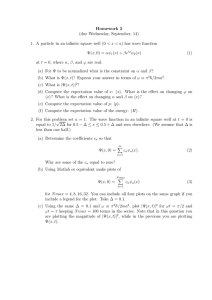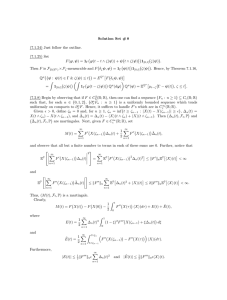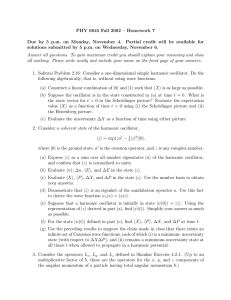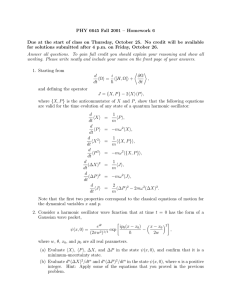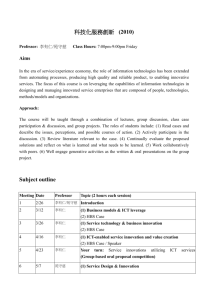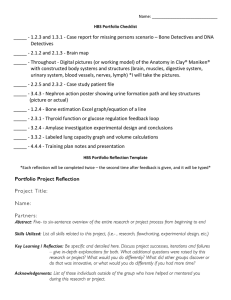18.155 LECTURE 24: 5 DECEMBER, 2013
advertisement
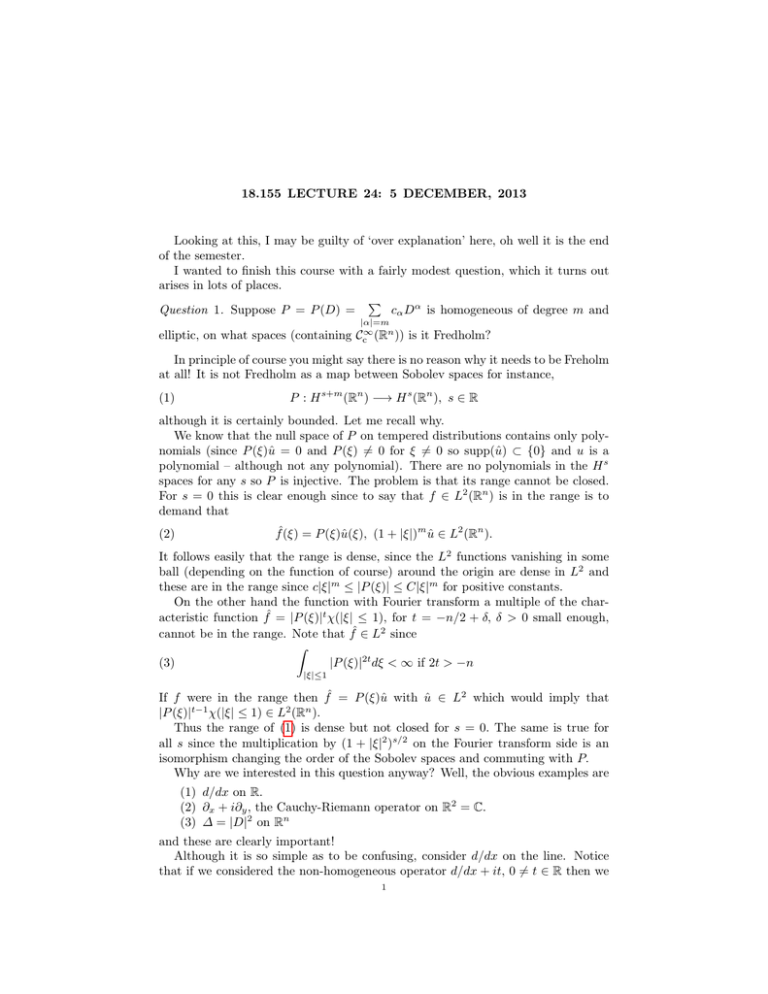
18.155 LECTURE 24: 5 DECEMBER, 2013
Looking at this, I may be guilty of ‘over explanation’ here, oh well it is the end
of the semester.
I wanted to finish this course with a fairly modest question, which it turns out
arises in lots of places.
P
Question 1. Suppose P = P (D) =
cα Dα is homogeneous of degree m and
|α|=m
elliptic, on what spaces (containing Cc∞ (Rn )) is it Fredholm?
In principle of course you might say there is no reason why it needs to be Freholm
at all! It is not Fredholm as a map between Sobolev spaces for instance,
(1)
P : H s+m (Rn ) −→ H s (Rn ), s ∈ R
although it is certainly bounded. Let me recall why.
We know that the null space of P on tempered distributions contains only polynomials (since P (ξ)û = 0 and P (ξ) 6= 0 for ξ 6= 0 so supp(û) ⊂ {0} and u is a
polynomial – although not any polynomial). There are no polynomials in the H s
spaces for any s so P is injective. The problem is that its range cannot be closed.
For s = 0 this is clear enough since to say that f ∈ L2 (Rn ) is in the range is to
demand that
(2)
fˆ(ξ) = P (ξ)û(ξ), (1 + |ξ|)m û ∈ L2 (Rn ).
It follows easily that the range is dense, since the L2 functions vanishing in some
ball (depending on the function of course) around the origin are dense in L2 and
these are in the range since c|ξ|m ≤ |P (ξ)| ≤ C|ξ|m for positive constants.
On the other hand the function with Fourier transform a multiple of the characteristic function fˆ = |P (ξ)|t χ(|ξ| ≤ 1), for t = −n/2 + δ, δ > 0 small enough,
cannot be in the range. Note that fˆ ∈ L2 since
Z
(3)
|P (ξ)|2t dξ < ∞ if 2t > −n
|ξ|≤1
If f were in the range then fˆ = P (ξ)û with û ∈ L2 which would imply that
|P (ξ)|t−1 χ(|ξ| ≤ 1) ∈ L2 (Rn ).
Thus the range of (1) is dense but not closed for s = 0. The same is true for
all s since the multiplication by (1 + |ξ|2 )s/2 on the Fourier transform side is an
isomorphism changing the order of the Sobolev spaces and commuting with P.
Why are we interested in this question anyway? Well, the obvious examples are
(1) d/dx on R.
(2) ∂x + i∂y , the Cauchy-Riemann operator on R2 = C.
(3) ∆ = |D|2 on Rn
and these are clearly important!
Although it is so simple as to be confusing, consider d/dx on the line. Notice
that if we considered the non-homogeneous operator d/dx + it, 0 6= t ∈ R then we
1
2
18.155 LECTURE 24: 5 DECEMBER, 2013
would indeed have an isomorphism on the standard Sobolev spaces. The aim is to
get to this point, but a certain effort is required.
One thing that you might try is to work on weighted Sobolev spaces, let’s think
about s = 0 (which it turns out does not matter because the operator is elliptic)
and try to find a space which makes d/dx into a Freholm operator into
1
(4) hxi−t L2 (R) = {u ∈ L2loc (R); u = hxi−t v, v ∈ L2 (R)}, hxi = (1 + |x|2 ) 2 , t ∈ R.
By Cauchy-Schwartz
(5)
hxi−t L2 (R) ⊂ L1 (R),
Z
Z
Z
1
1
1
|u|2 ≤ ( |v|2 ) 2 ( hxi−2t ) 2 if t > −
2
since the last integral is then finite.
So, let’s assume (5) and for convenience look at the subspace
Z
1
(6)
{f ∈ hxi−t L2 (R) ⊂ L1 (R); f = 0}, t >
2
R
which is clearly of codimension 1.
Then we can answer the question in a certain sense – by simply defining
Z x
1
(7)
Dt = {u ∈ L2loc (R); u(x) =
f (s)ds, f in (6)}, t > − .
2
−∞
Clearly d/dx : Dt −→ hxi−t L2 (R) has closed range of codimension one and no null
space. So it is Fredholm if we simply give it the topology from the range space
using the integral to identify them – i.e. make d/dx an isomorphism onto its range.
Of course this is a bit unsatisfactory, we really should try to see what the space
Dt is and what this topology on it looks like. We could do this by trying to estimate
the integral in (7) to see what the range is. However, I think it is much more fruitful
to try to manipulate d/dx as I indicated at the beginnning to ‘turn it into d/dx + is
although the variable will be different.
Let’s just look near x = −∞. Then the solution u ∈ Dt is the one that satisfies
d
u(x) = x−t g(x), on (−∞, −1), g ∈ L2 ,
dx
(8)
lim u(x) = 0.
x→−∞
Although it may seem counter-intuitive, we may multiply (8) by x and the equation
becomes instead
(9)
x
d
u(x) = x−t+1 g(x), on (−∞, −1), g ∈ L2 ,
dx
lim u(x) = 0.
x→−∞
1
If we commute a factor of x−t+ 2 (why this one?) through the equation we are
looking instead at
(10) (x
1
1
d
1
+ t − )x−t+ 2 u(x) = x 2 g(x), on (−∞, −1), g ∈ L2 ,
dx
2
lim u(x) = 0.
x→−∞
1
This is starting to look like what we are after! Especially if we set v = x−t+ 2 u(x)
and change the variable to z = − log(−x) (so it is still near −∞) and the equation
becomes
(11)
(
d
1
+ t − )v(z) = h(z) in z < 0.
dz
2
18.155 LECTURE 24: 5 DECEMBER, 2013
3
Why did I ‘leave a half power behind’ ? Well, the Jacobian of the coordinate change
2
is given by dx
x = dz so if g ∈ L then
Z
Z
Z
1
2 dx
2
2
(12)
|v(z)| dz = |x g|
= |g|2 dx
x
is ‘exactly in L2 ’ with respect to z.
So, what we are looking for is a solution of (11) when the RHS is in L2 (in z < 0
– extend it to be zero in z > 0). This we can do, there is a unique solution in L2
(with respect to z of course) since
1
d
1
(13)
( + t − ) : H 1 (Rz ) −→ L2 (Rz ) is an isomorphism for t 6= .
dz
2
2
So, now we can understand what the solution to (8) actually is!
Definition 1. For any s ∈ R define
(14)
s
Hbs (R) = {u ∈ Hloc
(R); χ± u(±ez ) ∈ H s (Rz )
where 0 ≤ χ± ∈ C ∞ (R) have support in ±x > 1 and are equal to 1 near ±∞.
Notice that for s = 0 the condition near x = ∞ is that
Z
Z
1
dx
< ∞ ⇐⇒ u = hxi 2 v, v ∈ L2 (Rx ).
(15)
|u(ez )|2 dz = |u(x)|2
x
Lemma 1. The spaces Hbs (R) defined by (14) are Hilbert spaces with
(16)
1
Hb0 (R) = hxi 2 L2 (R).
Proof. Take a partition of unity on R using χ± in (14) and 0 ≤ χ0 ∈ Cc∞ (R) and
set
(17) hu, vib,s = hχ0 u(x), v(x)iH s + hχ+ u(ez ), v(ez )iH s + hχ− u(−ez ), v(−ez )iH s
where the second two H s norms are with respect to the variable z.
The topology here is independent of the cut-offs since we can ‘shift’ terms supported in a compact region between the three parts.
Proposition 1. For any t 6= 0
(18)
d/dx : hxi−t+1 Hbs+1 (R) −→ hxi−t Hbs (R)
is Fredholm, with index −1 when t > 0 and index 1 when t < 0, it is not Fredholm
for t = 0.
s
The space hxi−t Hbs (R) consists of those u ∈ Hloc
(R) such that hxit u ∈ Hbs (R).
Proof. This is a matter of going backwards through the preceding discussion!
Now, what happens if we go to the general case? We need to ‘guess’ what the
analogues of the spaces in Definition 1 should be. For n > 1, we think in terms
of the radial action near infinity, which makes it look like Sn−1
× (0, ∞)r , r = |x|,
θ
θ = x/|x|. I claim we can be pretty confident about how to define Sobolev spaces
on a manifold such at Sn−1
× Ry .
θ
Then we can try the following
Definition 2. For any s ∈ R set
(19)
s
Hbs (Rn ) = {u ∈ Hloc
(Rn ); v(z, θ) = χu(ez θ) ∈ H s (Rz × Sn−1 )
where χ ∈ C ∞ (Rn ) has support in |x| > 1 and is identically equal to 1 in |x| > 2.
4
18.155 LECTURE 24: 5 DECEMBER, 2013
As before, observe that the case s = 0 is easy to analyse. Lebesgue measure in
polar coordinates r = |x|, θ = x/|x| is
dr
(20)
|dx| = rn |dθ|
r
were dθ is a strictly positive density on the sphere (the standard one in fact). It is
written this way since then
(21) |dx| = rn |dz||dθ|, z = log r, r = ez so u ∈ L2 (Rn )
n
=⇒ χ(|x|− 2 u)(ez θ) ∈ L2 (|dz||dθ|).
So in fact
(22)
n
Hb0 (Rn ) = hxi 2 L2 (Rn )
generalizing (16).
These spaces are sometimes called ‘homogeneous Sobolev spaces’. On reason for
this is that if u ∈ C ∞ (Rn ) is homogeneous of some real degree m in |x| > R then
(23)
u ∈ hxim+ Hbs (Rn ) ∀ s and ∀ > 0.
The following result is a better reason!
Theorem 1. Let P (D) be a homogeneous, elliptic constant coefficient differential
operator of order m on Rn , then
(24)
P : hxi−t+m Hbs+m (Rn ) −→ hxi−t Hbs (Rn )
is Fredholm when t 6= m − k, k = 0, 1, . . . , and t 6= n + j, j = 0, 1, . . . .
Notice that these two ranges of integers overlap if m ≥ n but there is a ‘gap’ if
m < n in the range t ∈ (m, n) in which it turns out that P is an isomorphism. The
null space is non-trivial only in the ranges (m − j, m − j − 1) for j = 0, 1, . . . where
it consists precisely of the polynomials in the null space of P (D) of degree at most
j – for t > m P in (24) is injective. Similarly for t ∈ (n + j, n + j + 1), j = 0, 1, . . . ,
the range of P has complement which is the null space of the corresponding space
of polynomial solutions for the adjoint. So in principle one also has a formula for
the index – which decreases as one crosses each of the integral thresholds.
